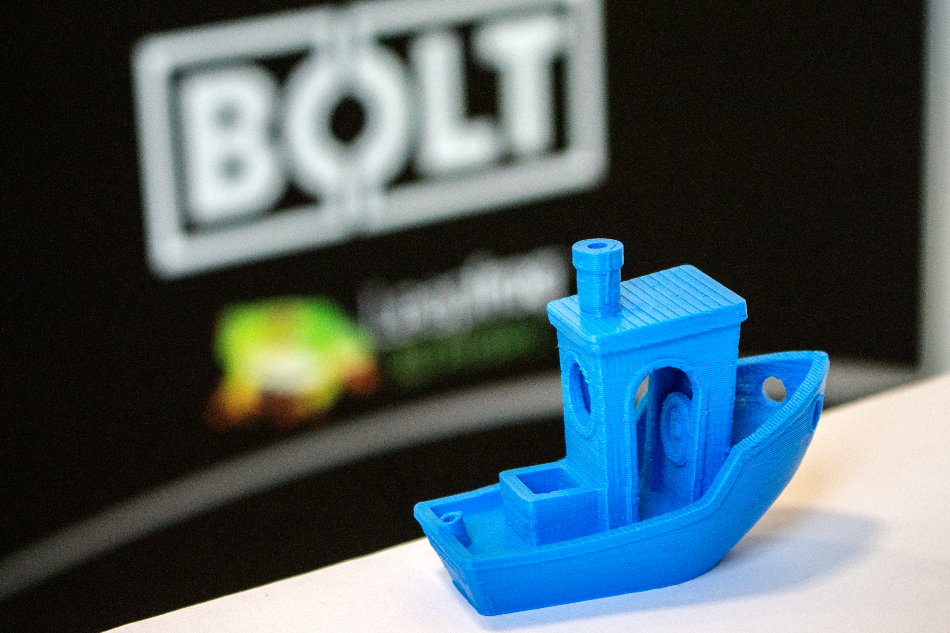Mar 10 2017
3D printer manufacturer Leapfrog, known for its Creatr line of 3D printers, introduced its latest desktop 3D printer, the Leapfrog Bolt, just a few months ago. The Bolt has a built-in camera, an activated HEPA carbon filter, and thanks to its set of dual extruders, features multi-color and multi-material 3D printing. Now the Bolt can add a new material to its wheelhouse – it has successfully 3D printed using plastic polypropylene (PP) filament, provided by materials and filaments expert Verbatim, a subsidiary of Mitsubishi Chemical Holdings Group. Verbatim, which was once known for its data storage and LED lighting systems, officially made its grand entrance into the 3D printing materials market a few years ago, and recently debuted some new high-performance filaments at the TCT Show in the UK.
 Benchy boat, PLA filament (Credit: Leapfrog)
Benchy boat, PLA filament (Credit: Leapfrog)
Leapfrog and Verbatim will both be exhibiting at the RapidPro show in the Netherlands until today, March 9. If you’re there, stop by and check out the Bolt 3D printing Verbatim’s polypropylene filament; you can also check out this time-lapse video of a Benchy boat 3D printed in PP, and see how well it stands up against one 3D printed in PLA (hint: the PLA boat started to decay after two hours, while the PP boat was still hanging on).
PP filament vs PLA filament | Verbatim & Leapfrog 3D Printers
PP has a large variety of consumer and industrial applications, with high chemical resistance and mechanical properties, and is one of the most used plastics in the world. It is FDM-approved, making it ideal for the packaging industry, and because it can withstand bumps without breaking, it’s a perfect material for children’s toys and automobile bumpers. Compared to PLA, it has a greater tendency to bend, and it can resist deformation better under a load. These properties, coupled with its high strength-to-weight ratio, make the lightweight PP a highly coveted 3D printing material, especially in terms of functional chemical 3D prints. But, even though we’ve seen 3D printing materials that simulate polypropylene, the material itself has been nearly impossible to successfully use in 3D print jobs.
Unfortunately, it’s difficult to control the results of 3D printing with the material, because PP undergoes a lot of heavy warping during the process: it’s a semi-crystalline material, which means that it cools and solidifies differently than amorphous polymers like ABS and PLA. This property means that the material undergoes a lot more stress during 3D printing, which causes the warping. But Verbatim and Leapfrog put their heads together, and figured out how to successfully 3D print this material on the Bolt 3D printer.
The Verbatim PP 3D printing filament, developed by the Mitsubishi Chemical Holdings Group, is available in both 1.75 mm and 2.85 mm, and had the right attributes to provide a perfect result on Leapfrog’s Bolt 3D printer. As shown in the video above, two Benchy boats were 3D printed, one in blue PLA and one in transparent Verbatim PP. While Verbatim advised Leapfrog to print the PP filament on 220°C, the 3D printer manufacturer learned that a temperature of 170°C offered up better results. The Bolt has a heated print bed and closed chamber, which allows it to keep track of the print temperature and prevent print warping, and its Direct Drive allows “optimum control for printing PP filament,” according to Leapfrog.
Once the Bolt 3D printed using Verbatim’s polypropylene filament, Leapfrog ran successful 3D printing trials using Nylon, polycarbonate, and flex materials, and can confirm that the desktop 3D printer is suitable for any type of 3D printing material. To learn more about polypropylene and its 3D printing process on the Leapfrog Bolt, take a look at this video: